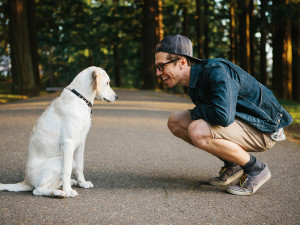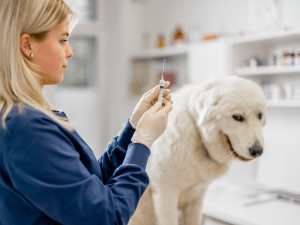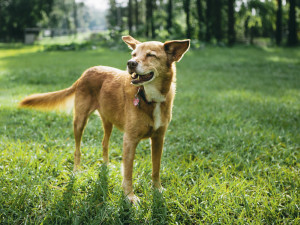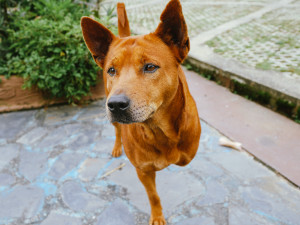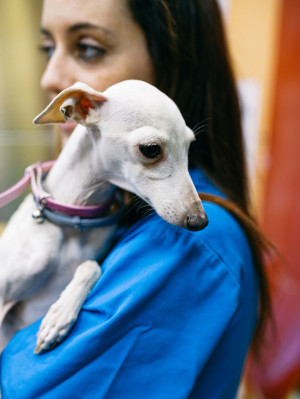Does Your Dog Need a Flu Shot?
“Sick as a dog” isn’t just a phrase.
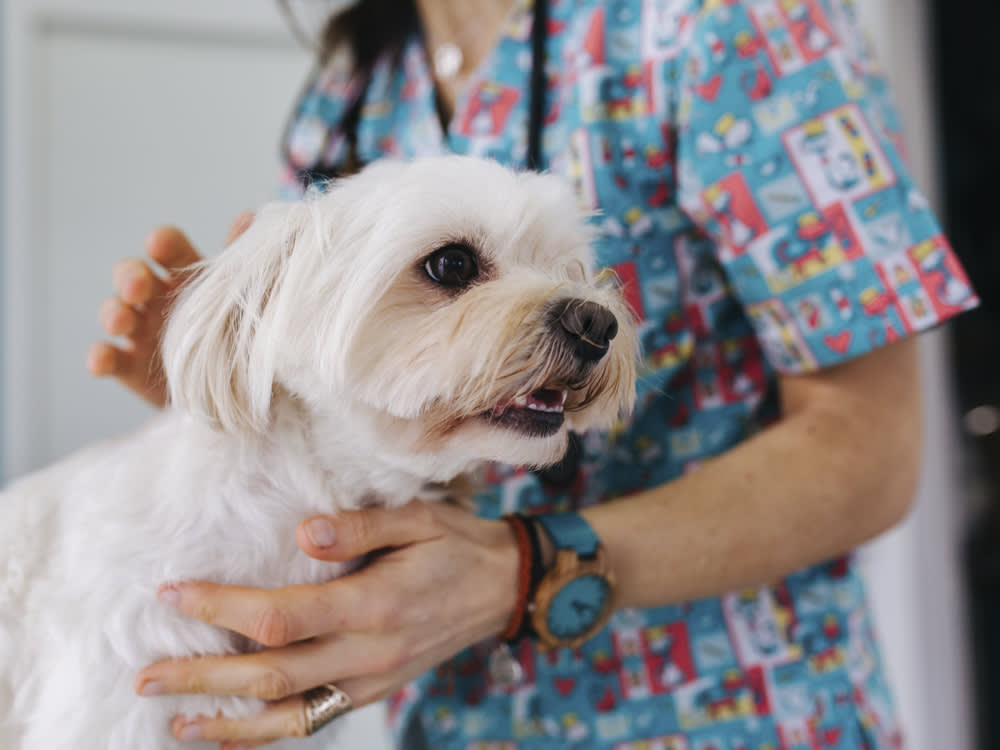
Share Article
It’s October, which means flu season is officially beginning. The Centers for Disease Control (CDC) recommendsopens in a new tab that people get their flu shots by the end of October — because when that cold weather hits, influenza’s in full swing. And it’s not just humans who need to keep up to date on their shots. Dogs can get the flu, too.
This summer, there were outbreaks of canine influenza in Florida,opens in a new tab Delaware,opens in a new tab Alabama,opens in a new tab and more states across the country. Unlike in humans, there’s no “flu season” for pups — dogs can get canine influenza year-round, so it’s important to be aware of what to look out for and how to get them help.

littleKin™ is Kinship’s home just for puppy and kitten parents. Bop over to check out expert advice, new pet tools, and special deals—all curated for your newest family member.
opens in a new tabThe illness is highly contagious, and while most dogs recover within a short period of time, complications can sometimes arise. Here’s everything you need to know about dog flu.
What is canine influenza?
Canine influenza comes in two strains: H3N8 and H3N2. Only 80 percent of dogs affected by dog flu show symptoms, but all infected dogs can spread the infection. It’s very rare, but canine influenza can be deadly; the fatality rate for influenza in dogs is less than 10 percent.
The H3N8 strain first appeared in Florida in 2004; scientists guess that it may have jumped from racehorses to Greyhounds. Then, in 2015, dogs in Chicagoopens in a new tab were diagnosed with H3N2. The latter strain was previously known to exist only in South Korea, China, and Thailand; it’s thought to have been transmitted to dogs by infected birds in live Asian bird markets, then possibly brought to the U.S. via imported dogs.
Dog flu targets the cells in the respiratory tract, which reaches from the nose to the small airways of the lungs, and causes mild-to-severe inflammation. Recovery typically takes two to three weeks. While any breed or age of dog can contract canine influenza, some pups are at higher risk — including puppies, pregnant dogs, dogs with respiratory disease, dogs with tracheal collapse, and those on immunosuppressive medication.
How is canine flu spread?
Canine influenza is primarily spread through respiratory droplets. During the two-to four-day incubation period before dogs show any signs of illness, the dog flu can spread through commonplace activities such as being patted on the head, sharing a tennis ball or water bowl, or a nose-to-nose greeting. Barking, nuzzling, and all kinds of everyday pup behaviors can also spread dog flu. Again, there is no “flu season” for dogs; they can contract this virus any time of the year. If your dog has the flu, most vets recommendopens in a new tab isolating them for 21 days to reduce the risk of transmission.
What are the symptoms of canine influenza?
Symptoms of the flu differ between dogs, but these are the most common signs:
A soft, dry cough that persists for 10 to 21 days despite treatment
Nasal congestion and/or thick nasal discharge
If your dog shows signs of canine influenza, take them to your veterinarian. To reduce its spread, ask the reception staff if you should stay in the car until they’re ready for the exam, and enter and exit by a side door if possible.
Influenza can be mistaken for kennel coughopens in a new tab (infectious tracheobronchitis). Bacteria, such as bordetella and mycoplasma and viruses such as parainfluenza, canine distemper, and canine adenovirus-2 present similarly.
Dogs with influenza, however, often spike fevers. You can monitor your pup’s temperature using a rectal thermometer, ideally every four to six hours to make sure it stays below 103 degrees Fahrenheit. A high-grade fever (104 to 106 degrees Fahrenheit) and increased respiratory rate and effort could mean that your dog is developing pneumonia; your vet can test for this using x-rays.
Treatment for the flu is supportive care. Based on your dog’s exam and signs, it may include antibiotics for secondary infections, fluid therapy, nutritional support, appetite stimulants, and dog-specific fever-reducing anti-inflammatory drugs. (Be sure not to share your meds — aspirinopens in a new tab, ibuprofen, acetaminophen, and other human pain killers can be toxic for dogs.) Most importantly, do your part to reduce the spread by keeping your sick dog home and away from other dogs. They should be isolated for at least four weeks. If you have multiple dogs, even those who seem healthy should also be quarantined; you never know if they’re carrying the flu.
Is there a dog flu shot, and should my dog get it?
The good news is, the dog flu shot is widely available. The first vaccine was approved in 2009 and initial tests showed no side effectsopens in a new tab.
A dog’s risk of exposure to the virus increases if they spend time at a kennel or go to daycare, the groomer, dog parksopens in a new tab or dog-friendly gatherings, or if a human in the house works around dogs.
The vaccine may not prevent an infection, but it can reduce its severity and duration. A bivalent vaccine that offers protection against both strains is also available. Ask your veterinarian about what’s best for your dog.
Tips for preventing the dog flu
The best thing you can do to keep your dog healthy is maintain their core vaccinesopens in a new tab (DHPP and bordetella), which will help them avoid a secondary respiratory infection. Other preventive tips are:
Bring your own water to the dog park.
When you come home, take your shoes off at the door and wash your hands immediately. (Yes, before you greet your pets. This is also a good practice for your own health.)
Leave leashesopens in a new tab and dog coatsopens in a new tab at the door.
Keep surfaces and textiles clean. Canine influenza tends to survive no longer than 48 hours in the environment and can be inactivated by common cleaners, such as a bleach-water solution. If a fabric item has come in contact with a sick dog, you should wash it in hot water with regular detergent.
Can people get the flu from dogs?
Currently, there is no data to suggest that the influenza virus is zoonotic — meaning that it can spread from dogs to humans — but because dogs may carry other viruses that are, it makes sense for young, elderly, pregnant, or immunocompromised people to avoid contact with ill animals.
While humans may not be susceptible, other animals might be. In 2016, cats in an Indiana shelter contracted canine influenza opens in a new tabH3N2, and experts suspected dog-to-cat transmission. Sick cats show symptoms including nasal discharge, fatigue, congestion, lip-smacking, and excess salivation.
So far, there is no indication that the H3N8 strain can be transmitted from dogs to horses, ferrets, or other animal species. However, there is some proof that guinea pigs and ferrets can become infected opens in a new tabwith H3N2.
Like most infectious diseases, when it comes to dog flu, prevention is key. For both our dogs’ benefit and our own, it’s best to follow the basic rules: wash hands frequently, keep up-to-date on vaccines, and stay home.
References:

Sara Greenslit, DVM
Sara Greenslit, DVM, CVA, is a small-animal veterinarian and writer who lives and practices in Madison, Wisc.
Related articles
![French bulldog puppy looking scared at vet]() opens in a new tab
opens in a new tab10 Things to Ask at Your First Vet Visit
There are no stupid questions — well, when it comes to your dog’s health.
![dog leaning on laptop while man types]() opens in a new tab
opens in a new tab7 Important Papers You Should Always Keep on File For Your Pet
It will be super helpful if you ever need a pet-sitter, too.
![tripod dog / dog with three legs]() opens in a new tab
opens in a new tabWhy You Should Adopt a “Less Adoptable” Dog
Here’s why you shouldn’t rule out senior dogs, special-needs pups, bully breeds, or tripods.
![Young woman carrying cute Italian Greyhound while working in modern veterinarian clinic.]() opens in a new tab
opens in a new tabA Mysterious Illness Is Making Dogs Across the Country Sick
Here’s what we know — and how to protect your pup.
![A dog outside with his mouth open coughing]() opens in a new tab
opens in a new tabRespiratory Illnesses in Dogs: 6 Serious Conditions Related to Coughing in Dogs
Vet advice on when you should be worried.
